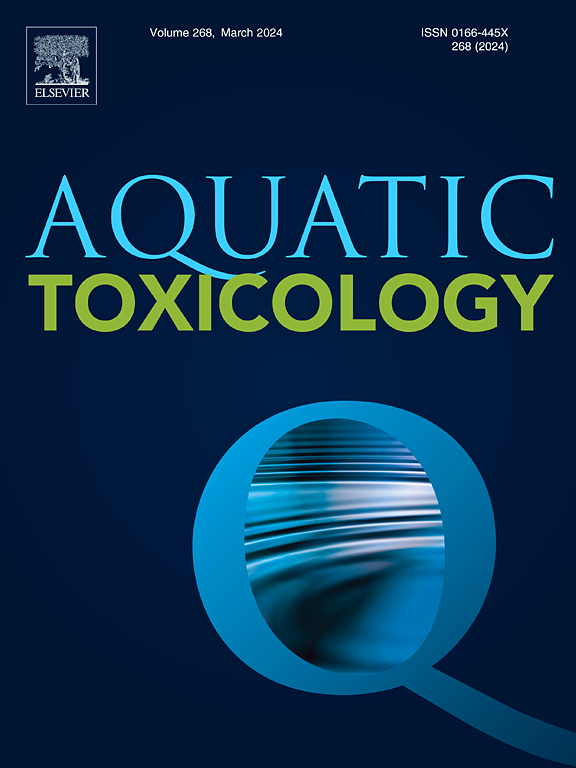揭示微塑料和新污染物对鱼类的综合影响:综述与荟萃分析
IF 4.1
2区 环境科学与生态学
Q1 MARINE & FRESHWATER BIOLOGY
引用次数: 0
摘要
微塑料(MPs)具有独特的吸附特性,使其表面容易吸附其他污染物。当微塑料与这些新出现的污染物相互作用时,可能会对鱼类产生不可预测的负面影响。之前的研究主要集中在单一污染物的影响上,而对综合污染的调查还没有引起足够的重视。因此,对综合污染的研究具有更大的现实意义。鱼类受新出现的污染物影响的生理指标以及这些影响背后的机制尚不完全清楚。为解决这一问题,我们进行了一项荟萃分析,以评估含 MPs 新兴污染物的综合污染对鱼类健康各方面的影响,包括行为、消费、发育和繁殖,以及鱼类氧化应激和神经毒性的评估。荟萃分析的结果表明,综合污染会对鱼类的繁殖、发育、氧化应激和神经毒性产生不利影响。重要的是,不同种类的鱼类对功能和氧化应激的易感性存在明显差异。对综合污染对鱼类影响机理的进一步研究表明,这种影响的程度与多孔介质本身的特性密切相关。吸附能力较强的多孔介质往往会导致更严重的后果,而吸附能力较弱的多孔介质的影响更多地依赖于其毒性。然而,并没有发现鱼类暴露于综合污染的时间长短与氧化应激水平之间存在密切联系。通过对现有研究的系统分析,本综述不仅探讨了综合污染对鱼类的累积效应,还强调了此类污染在水生生态系统中错综复杂的性质。该综述有助于加深对这一主题的了解,并强调有必要开展进一步研究,以揭示含有 MPs 的新兴污染物对水生生物的综合影响的复杂性。本文章由计算机程序翻译,如有差异,请以英文原文为准。
Unlocking the combined impact of microplastics and emerging contaminants on fish: A review and meta-analysis
Microplastics (MPs) possess unique adsorptive properties that render their surfaces prone to absorbing other contaminants. When interacting with these emerging contaminants, MPs may have unpredictable negative impacts on fish. Prior studies have primarily concentrated on the impact of single contaminants, while investigations into combined pollution have not received adequate attention. Therefore, research on combined pollution holds greater practical significance. The physiological indicators of fish affected by emerging contaminants and the mechanisms behind these effects are not yet fully clear. To address this issue, a meta-analysis was performed to evaluate the impact of combined pollution of MPs-containing emerging contaminants on various aspects of fish health, encompassing behavior, consumption, development, and reproduction, along with the assessment of oxidative stress and neurotoxicity of fish. The results of the meta-analysis indicated that combined pollution adversely impacted fish reproduction, development, oxidative stress, and neurotoxicity. Importantly, significant differences were observed between fish species regarding their susceptibility to function and oxidative stress. Further investigation into the mechanisms of the impact of combined pollution on fish revealed that the magnitude of this impact is closely associated with the characteristics of the MPs themselves. MPs with higher adsorption capacities tend to lead to more severe consequences, while the impact of MPs with lower adsorption capacities relies more on their toxicity. Nevertheless, a close correlation between the duration of exposure to combined pollution and the level of oxidative stress in fish was not identified. Through a systematic analysis of existing studies, this review not only explored the cumulative effects of combined pollution on fish but also highlighted the intricate nature of such pollution within aquatic ecosystems. It contributes to the growing body of knowledge on the subject and emphasizes the need for further research to unravel the complexities associated with the combined impact of MPs-containing emerging contaminants on aquatic life.
求助全文
通过发布文献求助,成功后即可免费获取论文全文。
去求助
来源期刊

Aquatic Toxicology
环境科学-毒理学
CiteScore
7.10
自引率
4.40%
发文量
250
审稿时长
56 days
期刊介绍:
Aquatic Toxicology publishes significant contributions that increase the understanding of the impact of harmful substances (including natural and synthetic chemicals) on aquatic organisms and ecosystems.
Aquatic Toxicology considers both laboratory and field studies with a focus on marine/ freshwater environments. We strive to attract high quality original scientific papers, critical reviews and expert opinion papers in the following areas: Effects of harmful substances on molecular, cellular, sub-organismal, organismal, population, community, and ecosystem level; Toxic Mechanisms; Genetic disturbances, transgenerational effects, behavioral and adaptive responses; Impacts of harmful substances on structure, function of and services provided by aquatic ecosystems; Mixture toxicity assessment; Statistical approaches to predict exposure to and hazards of contaminants
The journal also considers manuscripts in other areas, such as the development of innovative concepts, approaches, and methodologies, which promote the wider application of toxicological datasets to the protection of aquatic environments and inform ecological risk assessments and decision making by relevant authorities.
 求助内容:
求助内容: 应助结果提醒方式:
应助结果提醒方式:


